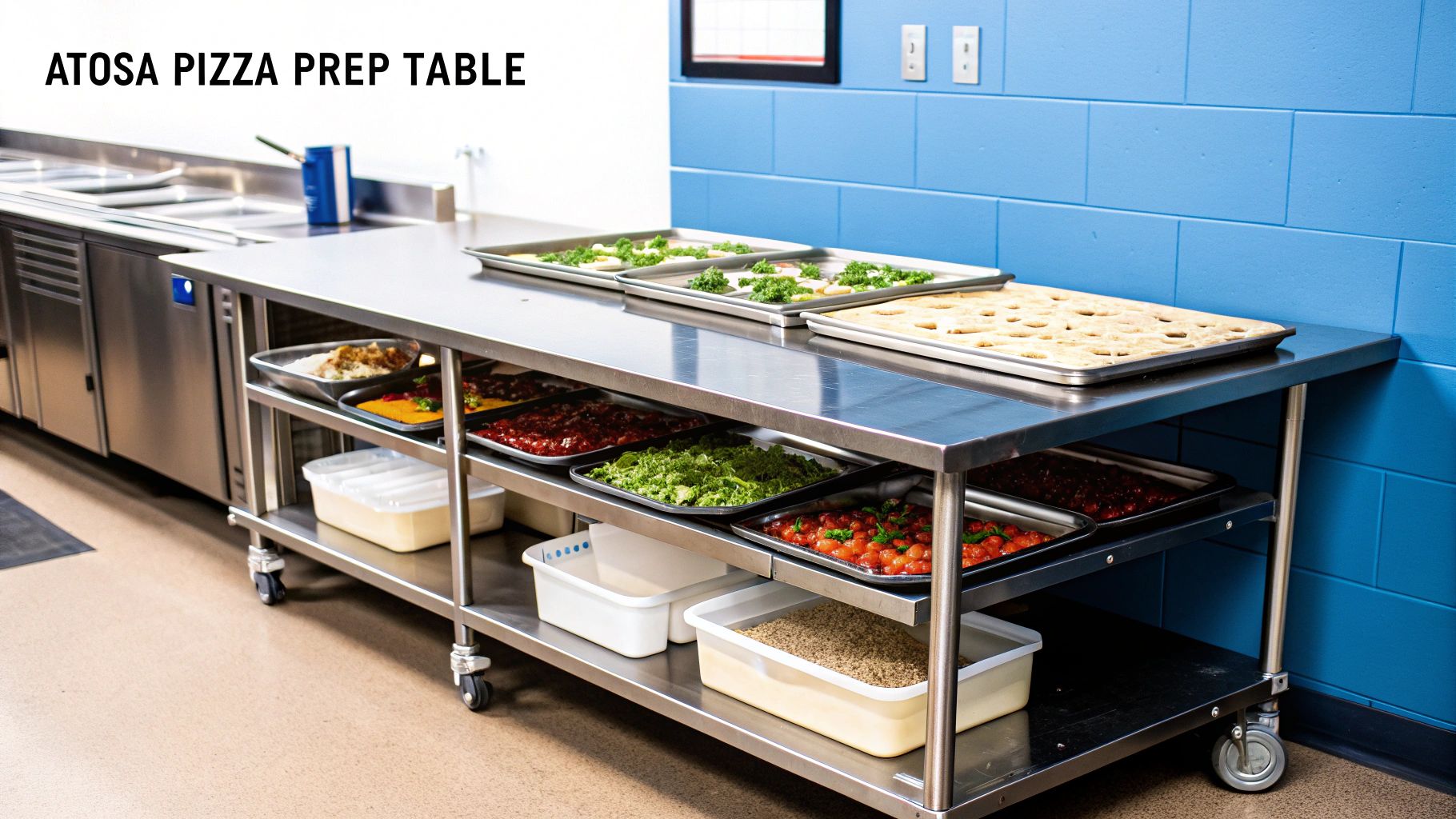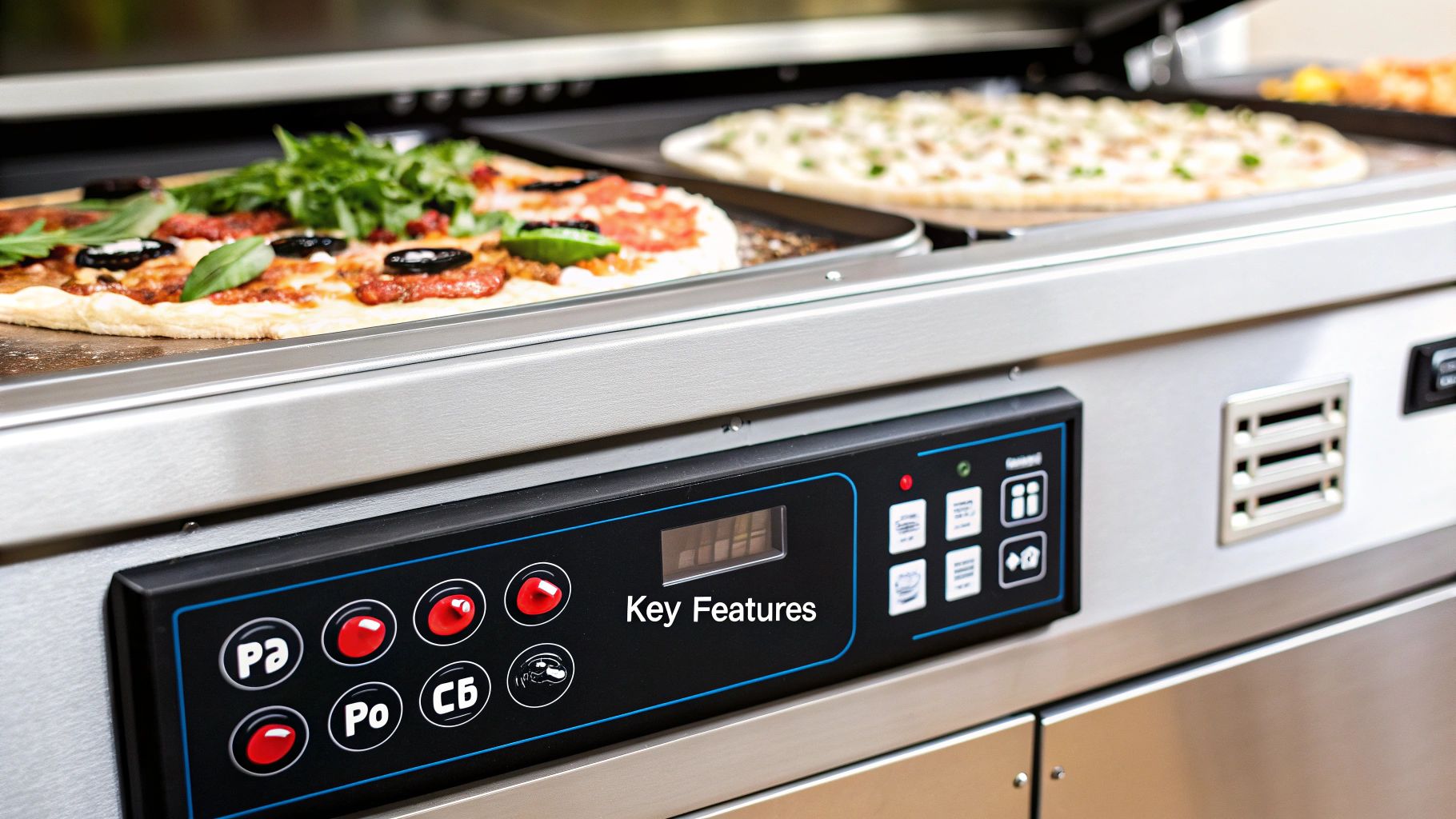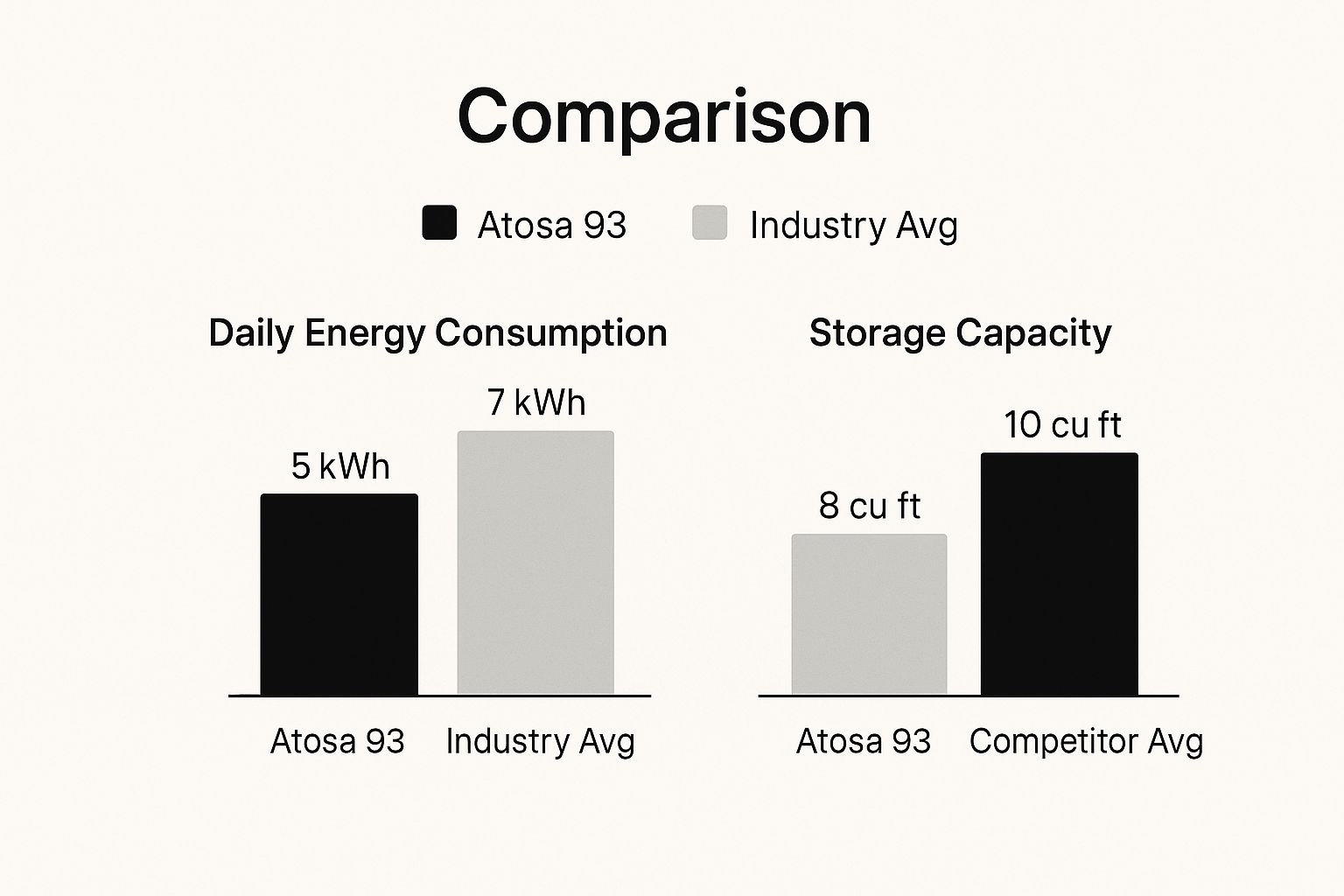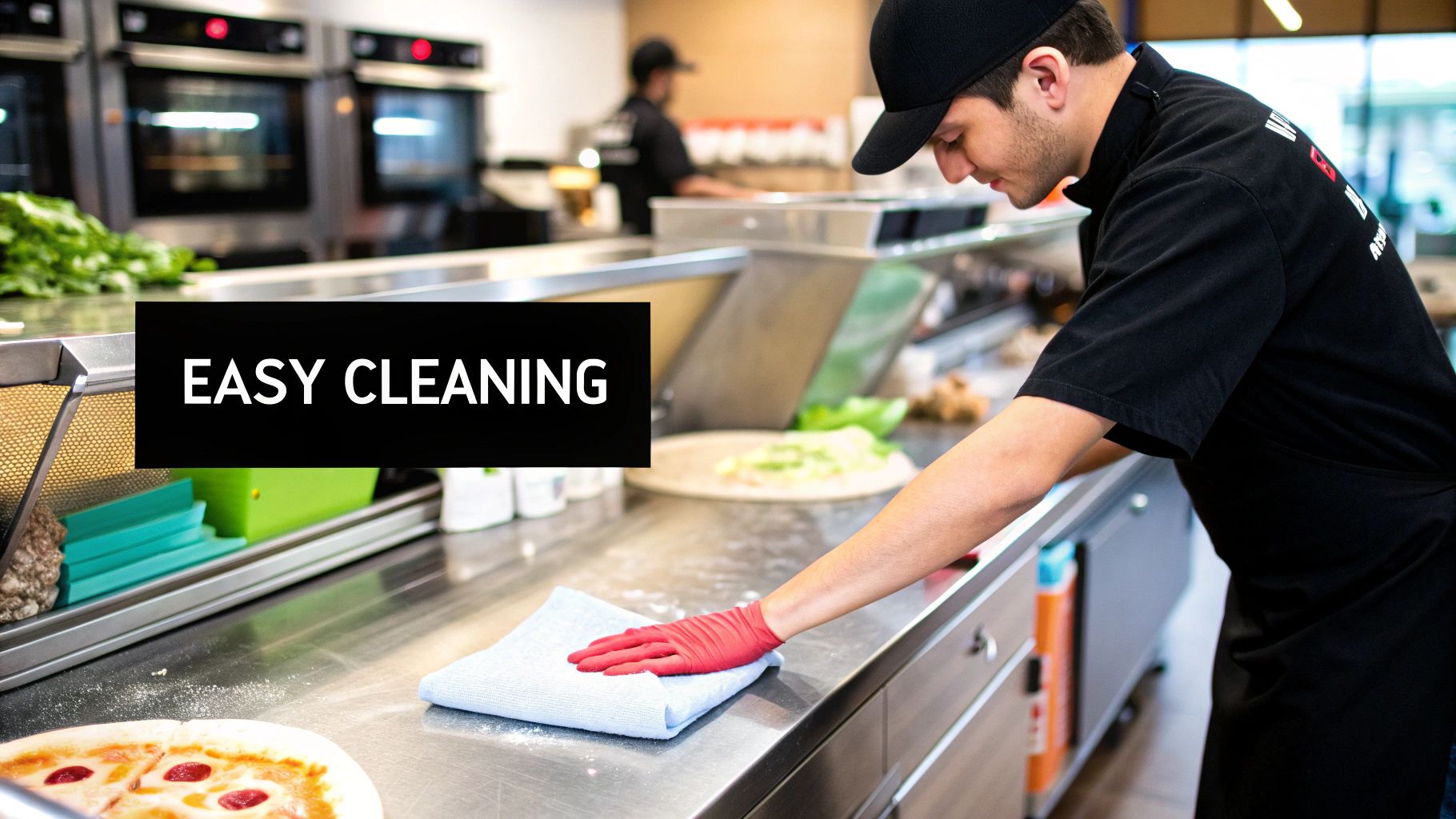
Atosa Pizza Prep Table 93 Pizzeria Efficiency Guide
Share
Picture your busiest dinner rush. Now, imagine it running smoothly, without the usual chaos. That's what the Atosa Pizza Prep Table 93 brings to the table. This isn't just a 93-inch piece of stainless steel; it’s the command center for your entire pizza operation, designed for serious efficiency and rock-solid food safety.
Why the Atosa 93 is Your Pizzeria's Workhorse
In any pizzeria that's pushing out a high volume of pies, the prep table is where the magic—and the money—happens. It’s the battle station where raw ingredients are transformed into delicious, finished pizzas. Speed here is everything. The Atosa Pizza Prep Table 93 was built with this in mind, not just as a workspace, but as a direct answer to the common bottlenecks that slow kitchens down.
This unit cuts out wasted movement by combining a massive, tough work surface with instant access to perfectly chilled ingredients. Think of it as the ultimate mission control for your pizza line.
A Smarter Pizza-Making Process
An efficient kitchen is all about flow, and the Atosa 93 creates a natural path from dough to box. Its huge 93-inch length gives multiple chefs plenty of elbow room to work together without tripping over one another. This kind of layout is absolutely essential for crushing ticket times and keeping the orders moving.
This drive for efficiency is a huge deal across the entire foodservice industry. In fact, the market for commercial pizza prep tables was valued at around USD 1.5 billion back in 2023 and is only expected to climb. That demand comes from restaurants just like yours, looking to standardize their kitchens for consistent quality and speed. It makes a beast of a unit like the Atosa 93 a true cornerstone investment.

A well-organized prep station is the difference between a chaotic kitchen and a profitable one. By centralizing ingredient storage and prep space, you empower your team to build pizzas faster and more consistently, directly impacting your bottom line.
A Smart Investment in Productivity
Just looking at the price tag of the Atosa 93 misses the whole point. It's an investment that pays you back every single shift in productivity and food safety. The built-in refrigeration keeps every topping at the perfect temperature, which means less spoilage and an easy pass on your next health inspection. All the while, its heavy-duty stainless steel build is made to take a beating from the relentless pace of a commercial kitchen.
Choosing the right equipment is fundamental to setting up a workspace that actually works. You have to understand all the options out there, from simple workbenches to these specialized refrigerated units. To get a better handle on picking the perfect model for your operation, take a look at our prep tables buying guide. When it comes down to it, the Atosa 93 lays the foundation for a smoother, more profitable service night after night.
Let's take a closer look at what makes the Atosa Pizza Prep Table 93 tick. When you get right down to it, this isn't just a big, shiny box. It's a thoughtfully engineered piece of equipment where every single feature works together to make your pizza line faster, cleaner, and more efficient. It’s those little details that elevate it from a simple table to the absolute heart of a kitchen.

The first thing you’ll probably notice is its solid stainless steel construction. This isn't just for show—it's a seriously practical choice for handling the beautiful chaos of a commercial kitchen. This heavy-duty material shrugs off dents, rust, and corrosion, meaning it can take all the spills, heavy pans, and constant wipe-downs you can throw at it without breaking a sweat.
That kind of resilience is non-negotiable for both longevity and hygiene. A smooth, non-porous surface is a breeze to sanitize, helping you nail those strict food safety standards without any extra hassle.
Built for Performance and Precision
Underneath that tough stainless steel shell is a refrigeration system that’s both powerful and smart. The Dixell digital temperature control acts like a personal bodyguard for your ingredients, holding a perfectly consistent and food-safe temperature. This precision is huge—it prevents spoilage, cuts down on waste, and directly protects your bottom line.
Another brilliant touch is the self-closing doors. It might sound like a minor detail, but in a busy kitchen, it’s a game-changer. When a cook is in the weeds and forgets to shut the door, it closes on its own, trapping the cold air inside. This simple feature drastically reduces the strain on the compressor and, over time, noticeably lowers your energy bills.
Think of it as an automatic money-saver. The system doesn't have to work overtime to make up for a moment of distraction, ensuring it runs at peak efficiency all day, every day.
Optimized for Workflow and Capacity
You can really judge a prep table by how much it can hold and how well it lets you work. The Atosa Pizza Prep Table 93 delivers on both fronts, offering a massive cabinet capacity to keep every single one of your essential ingredients close at hand. This is a big deal for any kitchen trying to balance high-volume storage needs with a practical workspace.
Having enough capacity is a major factor driving the commercial prep table market. In fact, industry research shows that units with significant refrigerated storage—often in the 12 to 24 cubic foot range—are what high-volume pizzerias and restaurants are looking for. These specs are key market trends, as businesses search for models that fit their operational needs like a glove. You can learn more about how these demands shape product design by checking out this research on pizza prep table capacity trends.
Beyond just raw storage, the layout of the pan rail is just plain smart. It keeps every topping right where you need it, letting chefs build pizzas with smooth, minimal movements. This kind of ergonomic design makes a real difference, reducing fatigue and speeding up the entire assembly line.
A great prep table doesn't just hold ingredients; it organizes your workflow. The layout should feel intuitive, turning repetitive actions into a fluid, efficient motion that boosts speed and consistency.
To give you a clearer picture, here’s a quick summary of the Atosa 93’s core specs and how they directly benefit your kitchen.
Atosa Pizza Prep Table 93 Key Specifications at a Glance
| Feature | Specification | Benefit for Your Kitchen |
|---|---|---|
| Construction | Stainless Steel Exterior & Interior | Resists damage, prevents rust, and is easy to sanitize, ensuring long-term durability and hygiene. |
| Temperature Control | Dixell Digital Controller | Provides precise temperature management, protecting ingredient freshness and food safety. |
| Doors | Self-Closing, Stay-Open | Enhances energy efficiency by preventing cold air loss and improves workflow with a stay-open feature. |
| Refrigeration | Heavy-Duty Compressor | Delivers powerful and reliable cooling, even in hot kitchens, to maintain optimal product temperature. |
Ultimately, this table shows how each component was chosen not just for its quality, but for its real-world impact on your daily operations.
Choosing the Right Commercial Prep Table
Picking the right prep table for your kitchen is a lot like a chef choosing the perfect knife—the right tool makes all the difference. Not every stainless steel table is built for the same job, and getting a handle on their core differences is the first step to building a truly efficient workspace.
The most basic option out there is the simple stainless steel work table. Think of this as your kitchen's blank canvas. It’s just a durable, flat surface that’s great for general tasks like chopping vegetables, portioning dough, or plating dishes. But it has no built-in refrigeration or ingredient wells. It's a foundational piece, but it forces your cooks to constantly walk back and forth to a separate fridge, which adds steps and really slows down service.
Specialized Prep Tables for Speed and Safety
To crush that problem, specialized refrigerated prep tables came along. These units pack cold storage right under the work surface, creating a self-contained station where every single ingredient is within arm's reach. This is where the really important distinctions pop up. You can dive deeper into the different categories in our guide covering the types of stainless steel prep tables available for commercial kitchens.
Two of the most common specialized units you'll see are pizza prep tables and sandwich/salad prep tables. At first glance, they might look pretty similar, but they're actually engineered for completely different workflows. Grabbing the wrong one can create some seriously frustrating bottlenecks right in the middle of your busiest hours.
A sandwich prep table, for example, usually has a much shallower cutting board, maybe around 10 inches deep. That’s perfectly fine for putting together sandwiches, subs, and salads. But try to build a large 16-inch or 18-inch pizza on it, and you'll see the problem immediately. It’s way too narrow, forcing the chef to work awkwardly and risk ingredients spilling all over the place.
Pizza Prep Table vs. Sandwich Prep Table Key Differences
So, how do you choose the right one for your kitchen's flow? This table breaks down the essential differences between a pizza table and a standard sandwich/salad prep table.
| Feature | Pizza Prep Table (e.g., Atosa 93) | Sandwich/Salad Prep Table |
|---|---|---|
| Cutting Board Depth | Extra-deep, typically 19+ inches to handle large pizza bases. | Shallow, around 10 inches, designed for smaller items. |
| Pan Rail Design | Raised to keep cold air off dough and for easier topping access. | Flush or low-set, ideal for quick access to sliced items. |
| Workflow Focus | High-volume assembly of large, complex items like pizzas. | Fast assembly of linear items like sandwiches and subs. |
This is exactly where a purpose-built unit like the Atosa Pizza Prep Table 93 really shines. As you can see, it features an extra-deep cutting board, giving you a massive 19-inch surface. That provides plenty of room to sauce, cheese, and top even your biggest pies without any hassle. This one design choice makes a huge difference in ergonomics and speeds up the entire pizza-making process.
Another key difference is how the pan rail is designed. Pizza tables have a raised pan rail that lifts the ingredient bins higher. This setup is specifically designed to stop cold air from blowing directly onto your delicate pizza dough, which can prevent it from rising the way it should. The raised rail also makes it much easier for chefs to grab handfuls of cheese and other bulky toppings without constantly reaching down, which really cuts down on physical strain over a long shift.
This quick chart shows how the Atosa 93's energy use and storage capacity stack up against typical industry averages.

As the data makes clear, the Atosa 93 isn't just more energy-efficient—it also gives you more storage, making it a much smarter investment for the long haul.
Alright, your new Atosa Pizza Prep Table 93 has landed in your kitchen. Let's get it out of the box and humming along so you can start making money with it. A proper setup right from the start is the secret to a long, trouble-free life for your equipment.
I'll walk you through the essential steps to make sure your table is installed correctly and ready for the dinner rush.

From Box to Battle-Ready
First things first: get it unboxed carefully. Be patient and avoid using box cutters or sharp tools that could leave a permanent scratch on that beautiful stainless steel finish. It's best to move the main unit into its final home before you attach the casters. It’s just easier that way.
Now, where you put it matters more than you'd think. This isn't just about finding an open spot on the line. Your Atosa table needs to breathe to stay cool and efficient.
- Give It Some Room: Make sure you leave at least 4-6 inches of clear space around the back and sides. This is non-negotiable. The compressor needs that airflow to dissipate heat, preventing it from overworking and keeping the refrigeration system healthy.
- Keep It Level: Grab a level and make sure the table is perfectly flat. If it’s tilted even slightly, the doors might not seal correctly. That means cold air escapes, your energy bill goes up, and your food temps can get inconsistent.
Once it's in the right spot, go ahead and attach the casters. Make sure they're on tight, and don't forget to lock the brakes on the front two wheels to keep it from rolling away mid-service.
The First Power-Up and Sanitization
Before you even think about plugging this unit in, it’s time for a deep clean. Every single surface that will touch food needs to be thoroughly washed and sanitized. We're talking about the cutting board, the entire inside of the cabinet, and every last ingredient pan. Follow your local health code standards to the letter.
With everything sparkling clean and completely dry, you're ready for the moment of truth.
"A pro tip: never turn on a commercial refrigeration unit when it's totally empty inside. Always have the shelves and pan supports in place first. Firing up an empty box can put a weird strain on the cooling system right from the get-go."
Plug the unit into its own dedicated electrical outlet—don't share it with other high-draw appliances. Use the digital thermostat to dial in your target temperature. For most pizza toppings, somewhere between 33°F and 41°F (0.5°C and 5°C) is the sweet spot.
Now, walk away. Let the table run for a few hours to pull down to that set temperature and stabilize. This cool-down period is critical for food safety. The last thing you want is to load it up too early.
Once it’s holding temp, you can load your ingredient pans. Think about your workflow—arrange your cheese, pepperoni, veggies, and sauces in a logical order to create a super-efficient assembly line for your team. A little thought here saves a ton of time during a busy shift.
Maintenance Tips for Peak Performance
A serious piece of kitchen equipment like the Atosa Pizza Prep Table 93 is a major investment. But it's only a good investment if it lasts. The key to protecting that investment is a simple but consistent maintenance routine.
Think of it like changing the oil in your delivery car. It's a small task that prevents a catastrophic, expensive failure down the road. Sticking to a few daily, weekly, and monthly habits is the secret to getting years of reliable service and perfect cooling performance. This small time commitment is your best defense against the most common equipment failures.
Your Daily Maintenance Checklist
The foundation of any healthy kitchen and reliable piece of equipment starts with simple daily habits. These quick steps, done at the end of every shift, stop grime from building up and are non-negotiable for food safety.
- Wipe Down All Surfaces: Grab a food-safe cleaner and a soft cloth. Give all the stainless steel surfaces—inside and out—a thorough wipe-down. This gets rid of spills and stops corrosive food acids from eating away at the finish.
- Sanitize Food Contact Areas: The cutting board, the pan rail, and the interior cabinet shelves need to be cleaned and sanitized without fail. This is critical for passing health inspections and preventing cross-contamination.
- Clear Debris: Do a quick sweep for any crumbs or bits of food that have fallen into the main cabinet or gotten stuck around the door gaskets.
These tasks only take a few minutes, but they are absolutely essential for the day-to-day health of your Atosa table.
Weekly and Monthly Checks for Longevity
Ready to step up your maintenance game? A couple of deeper checks each week and month can head off the vast majority of equipment breakdowns. These tasks focus on the parts that take the most abuse or are critical to the refrigeration system.
A crucial weekly job is to inspect the door gaskets. These rubber seals are what keep the cold air locked in. Run your finger along the entire seal, feeling for any cracks, tears, or spots that have gone hard and brittle. A bad seal makes the compressor work overtime, which wastes energy and will eventually cause it to fail.
The single most important monthly task is to clean the condenser coil. This is the heart of your table's cooling system.
Think of a dirty condenser coil like a car radiator clogged with mud. It can’t release heat effectively, causing the engine—or in this case, the compressor—to overheat and fail. This is the number one cause of refrigeration breakdowns.
To clean it, always unplug the unit first. Find the coil, which is usually behind a grille on the front or side. Use a stiff-bristled brush and a vacuum to gently clear away all the dust, grease, and grime that's built up. Doing this every single month will dramatically boost your table's efficiency and add years to the life of your compressor.
Basic Troubleshooting for Common Issues
Even with perfect maintenance, small issues can pop up. Knowing how to quickly diagnose them can save you the cost and headache of a service call.
| Problem | Possible Cause | Simple Solution |
|---|---|---|
| Unit Not Cooling | Is it plugged in? Is the breaker tripped? | Check the power cord and your circuit breaker box before calling a technician. It's the oldest trick in the book for a reason. |
| Temperature is Too High | The condenser coil is dirty or the door was left ajar. | Give that condenser coil a good cleaning and make sure the self-closing doors are actually swinging shut and sealing properly. |
| Frost Buildup Inside | The door gasket has a poor seal. | Inspect the gasket for damage. If it's torn, brittle, or hardened, it's time for a replacement. |
Arming yourself with this basic knowledge helps you squash small problems before they turn into big ones that shut down your service. A well-maintained Atosa pizza prep table 93 will be a reliable partner in your kitchen for a long, long time.
Answering Your Final Questions About the Atosa 93 Prep Table
Even with all the details covered, you probably have a few practical questions running through your mind before you pull the trigger on the Atosa Pizza Prep Table 93. I get it. This is a big decision. Let's tackle the most common questions I hear from kitchen managers and restaurant owners to make sure you have every last bit of info you need.
What Kind of Warranty Does Atosa Offer?
When you’re investing in serious kitchen equipment, you need to know the manufacturer has your back. Atosa offers a really solid warranty package that shows they believe in their product.
You're looking at two years of coverage on parts and labor, which is great. But the real standout is the five-year warranty on the compressor. The compressor is the engine of any refrigeration unit, and having it protected for that long is a huge deal. It’s the most expensive component to fix, so that five-year coverage offers some serious peace of mind.
How Energy Efficient Is This Prep Table?
Let’s be honest, energy bills can eat into your profits. The Atosa 93 was built with modern efficiency in mind. It runs on R290 hydrocarbon refrigerant, which is a big win. Not only is it better for the environment, but it's also more efficient than the older refrigerants you'll find in legacy equipment.
Features like self-closing doors and top-notch insulation also play a big part in keeping electricity use down. While your exact costs will depend on your kitchen's ambient temperature and how hard you're running it, this unit is designed to keep your utility bills in check compared to older models.
Here's a pro tip: the single best way to keep this unit energy-efficient is through proper maintenance. Just keeping the condenser coil clean can slash energy use by as much as 30% and ensure the table runs like it's supposed to.
What Size and Type of Pans Can It Hold?
Flexibility is key on the prep line, and the Atosa 93 delivers. The pan rail is built to handle standard foodservice pans, and it even comes with twelve 1/3 size food pans right out of the box. That’s a perfect starting point for loading up on cheese, pepperoni, veggies, sauces, and whatever else your menu demands.
But you're not locked into that single configuration. The rail is designed so you can swap in other standard pan sizes. Need to add smaller portions? Pop in some 1/6 or 1/9 size pans. You can mix and match to create the perfect layout for your unique workflow, and that adaptability is priceless as your menu evolves.
Are There Customization Options Available?
The core unit is a fantastic, standardized workhorse, but you can definitely tweak it to fit your space better.
A very popular add-on is overshelves. You can get single or double-tiered shelves that mount right above the work surface. This gives you a ton of extra storage for pizza boxes, spice shakers, or small utensils without eating up any more of your valuable floor space.
Another practical tweak is the casters. The table ships with standard 6-inch casters, but you can often get smaller ones if you need to adjust the working height. This is great for matching it to the rest of your kitchen line or just making it more comfortable for your crew. For a deeper dive into the standard features that make this model a winner, check out our complete overview of the Atosa Pizza Prep Table. These little adjustments can make a huge impact on your team's day-to-day efficiency.
Ready to make your pizza line faster, smarter, and more reliable? The Atosa Pizza Prep Table 93 is the workhorse your kitchen deserves. Explore our full range of professional kitchen equipment at PrepTables.com and find the perfect tools to boost your productivity.
